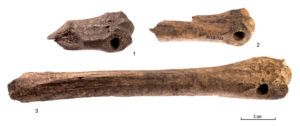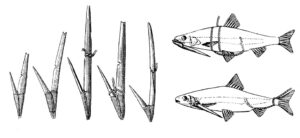Animal furs, skins, bones, and other byproducts were used and sold in craftmaking during the Viking Age.
| “It is likely that awareness of European trade and the diverse, wealthy kingdoms it connected exerted some pull on Scandinavian aristocracies. More precisely, there must have been an appreciation of the increasing quantities of silver entering the Baltic and North Sea regions from the south-east. The markets of the Caliphate were producing ever-growing demand for northern products such as slaves and fur, with increasing quantities of silver going in the other direction.”
Ashby 2015, 91 |
Current literature on the Viking Age has suggested that one of the causes of the Viking Age expansion and increased maritime voyages was that Scandinavian fur was desired by markets of the Islamic Caliphate. |
 Tunic from Bjerringhøj, DK. |
This reconstructed Viking Age costume features a man’s woolen tunic with a special embroidered cloth of animal imagery, including leopards and birds. These textiles were based off of small excavated clothing pieces. While leopards were not coexisting with humans in Scandinavia, this Viking Age clothing imagery most likely originated from stories and verbal descriptions of leopards or imported embroidered clothing showing leopards that were then copied once in Scandinavia. |
| “He chiefly went there {…} for the walruses, because they have very fine bone in their teeth – they brought some of the teeth to the king – and their hide is very good for ship’s ropes.”
Ohthere and Wulfstan, 45 |
Animal furs were also used as payment during the Viking Age. As indicated by Ohthere and Wulfstan, such payment included marten skins, reindeer skins, feathers, bear skins, otter skins, whale hide rope, and seal hide rope. These wild animal furs (fox, marten, beaver, squirrel, ermine, sable) were also used for clothing, while domesticated animals were used for leather production. Additionally, walrus bone was used for craft and ornament and walrus hide was used for ship ropes, as described in the quote. |
 Crozier from Denmark. |
This is a bishop’s staff or crozier from the collections of the National Museum of Denmark. Although little is known about this staff, it is made from walrus ivory and topped with a scrolling beast reminiscent of Viking Age animal motifs. It helps indicate the prestige that objects made from walrus ivory could give to their owners. |
| “All soles that could be identified to species were found to be made of cattleskin, as are rands; whereas sheep is the species identified for all lace samples. The uppers can be made of either cattle or goatskin, and, in a few cases, sheep skin.”
Brandt et al. 2020, 441
|
Leather shoes found in Viking Age graves in Denmark have been analyzed for animal source, with different animal leathers having properties more well-suited for use as different parts of shoes. |
 Ice skates (broken).  Composite fish hooks. |
Bones were commonly crafted to make ornaments, fish hooks, and ice skates during the Viking Age (Luik and Maldre). Excavated fishing gear and skates made of bone can be seen in the attached images.. |
| “The fact that products such as reindeer antler were infiltrating the urban networks of the North Sea and the Baltic speaks to the articulation between the towns of southern Scandinavia, and the outland areas of the north. That tells us something more profound than simply the geography of the north versus south; it speaks to the relationship between these nodes of travel and trade, and what might be seen as much more marginal, frontier-like areas.”
Ashby et al., 696 |
Antlers were also used to create objects in Viking Age Scandinavia, with many hair combs made out of antlers. These combs also help us understand the geographical spread of Viking Age trade as some combs found in Scotland were made of reindeer antlers, but reindeers weren’t found in the British Isles during the time, so the combs must have been imported. There were also some combs found made of native red deer antlers, but many antler items were mostly likley crafted by local artisans who were shipped reindeer antlers from the north. |
Ashby, Steven P. “Combs, Contact and Chronology: Reconsidering Hair Combs in Early-Historic and Viking-Age Atlantic Scotland.” Medieval Archaeology 53 (2009): 1–33. (online)
Ashby, Steven P. “What Really Caused the Viking Age? The Social Context of Raiding and Exploration.” Archaeological Dialogues 22, no. 1 (2015): 89–106. (online)
Ashby, Steven P., Ashley N. Coutu and Søren M. Sindbæk. “Urban Networks and Arctic Outlands: Craft Specialists and Reindeer Antler in Viking Towns.” European Journal of Archaeology 18, no. 4 (2015): 679–704. (online)
Bately, Janet. “Text and Translation: The Three Parts of the Known World and the Geography of Europe North of the Danube According to Orosius’ Historiae and Its Old English Version.” In Ohthere’s Voyages: A Late 9th-Century Account of Voyages along the Coasts of Norway and Denmark and Its Cultural Context, edited by Janet Bately and Anton Englert, 40–58. Roskilde: Viking Ship Museum, 2007.
Brandt, Luise Ørsted, Alberto J. TaurozziI, Meaghan MackieI, Mikkel-Holger S. Sinding, Filipe Garrett Vieira, Anne Lisbeth Schmidt, Charlotte Rimstad, Matthew J. Collins, and Ulla Mannering. “Palaeoproteomics Identifies Beaver Fur in Danish High-Status Viking Age Burials – Direct Evidence of Fur Trade.” PLoS ONE 17, no. 7 (2022): e0270040. (online)
Brandt, Luise Ørsted, Jannie Amsgaard Ebsen, and Kirstine Haase. “Leather Shoes in Early Danish Cities: Choices of Animal Resources and Specialization of Crafts in Viking and Medieval Denmark.” European Journal of Archaeology 23, no. 3 (2020): 428–50. (online)
Luik, Heidi, and Liina Maldre. “Animal Bones and Bone Artefacts from the Viking Age Site of Tornimäe in Saaremaa.” Archaeologia Lituana 21 (2020): 41–58. (online)
National Museum of Denmark. “Dragten – en yderst eksklusiv mandsdrag” = The Suit – An Extremely Exclusive Men’s Suit. (online)
« Previous | Home | Next »